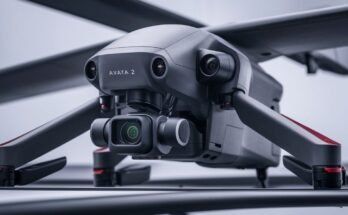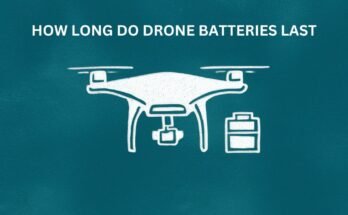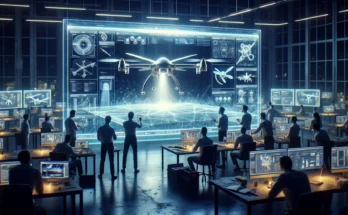Introduction to Drone with Infrared Camera
Drone with infrared camera represent a significant advancement in aerial imaging technology. These specialized drones are equipped with thermal imaging sensors that detect heat signatures and translate them into visible images, allowing for enhanced visibility in various environmental conditions, including low light and darkness.
Explanation of the Technology:
Infrared technology operates by detecting thermal radiation emitted by objects, which is invisible to the naked eye. The sensors onboard the drone capture this radiation and convert it into a visual representation, commonly displayed in grayscale or false color images. This allows operators to identify temperature variations and heat sources that may be crucial for a variety of applications.
Importance in Various Industries:
The application of drone with infrared camera spans across a multitude of industries, each leveraging the technology for specific purposes. In agriculture, these drones are used for crop monitoring, disease detection, and irrigation management, as they can identify areas of stress or moisture variation in fields.
In search and rescue operations, thermal imaging capabilities enable responders to locate missing persons or survivors in challenging terrain or low visibility conditions, significantly improving search efficiency and reducing response times.
Building inspections benefit from the use of drones equipped with infrared cameras, as they can detect structural issues, insulation deficiencies, or water leaks that may be invisible to the naked eye but manifest as temperature variations in the thermal images captured by the drone.
Overall, drone with infrared camera have revolutionized numerous industries by providing valuable data and insights that were previously inaccessible or difficult to obtain, thereby enhancing efficiency, safety, and decision-making processes.
This introduction sets the stage for understanding the significance of drone with infrared camera, laying the foundation for further exploration into the technology and its applications in subsequent sections of the article.
Understanding Infrared Technology in Drone Cameras

Infrared technology lies at the core of drones equipped with infrared cameras, enabling them to capture thermal images that reveal temperature variations in their surroundings. Understanding how this technology works is essential for appreciating its capabilities and applications.
How Does It Work?
Drone with Infrared camera, more commonly known as thermal imaging cameras, measure the amount of heat released by objects using the infrared radiation they detect. The difference between infrared radiation from visible light lies beyond our ability to sight; infrared extends into the spectrum beyond what we can see, thus giving the cameras an ability to detect thermal signatures even in the dark or through certain materials.
The key components of an infrared camera include:
- Infrared Sensor: The sensor detects the infrared radiation that is emitted by the objects in the camera’s area of observation. The infrared cameras emit radiation based on their temperature in different materials, hence allowing for a differentiation of these materials.
- Optics: The optics concentration infrared radiation onto the sensor surface by focusing the camera thus capturing the images.
- Image Processing: After being the sensor is irradiated by the infrared radiation, the onboard software of the camera starts to process it to create a thermal image. This picture is usually presented in grayscale or false color, where warmer areas become bright areas while cooler areas become dark areas.
The main Benefit of infrared Technology in the Working of Drone Cameras is its Ability to Identify and Visualize Thermal Signatures. This capability offers several advantages over traditional visible light
Camera: This capability offers several advantages over traditional visible light cameras:
- Visibility in Low Light Conditions: Infrared cameras are capable of capturing thermal images even in low light or complete darkness because the good thing here is that they are perfect for night-time surveillance or search and rescue operations.
- Detection of Heat Signatures: Through the recording of temperature changes, the infrared cameras can locate hotspots, cold spots, and other irregularities which might be problematic such as machine failures, energy wastage and even the presence of life.
- Enhanced Situational Awareness: Infrared imaging presents a very special view of the environment since it let nature enthusiasts see beyond what the human eye can see. It is a strong additional to the situational awareness for many applications such as surveillance, inspection and environmental monitoring.
Application of the underlying principles of infrared technology allows users to reap the maximum benefit that the drones fitted with infrared cameras have to offer. In the next section, we’re going to investigate exactly how these drones are of benefit in different industries.
Benefits of Using Drone with Infrared Camera
Drones equipped with infrared cameras offer a multitude of benefits across various industries, thanks to their ability to capture thermal images and detect temperature variations. Understanding these benefits is essential for appreciating the practical applications and value of this technology.
Enhanced Visibility in Low Light Conditions:
Visual enhancement is a major benefit of using unscrewed aerial vehicles with infrared sensors. This is because of their ability to see well in low light conditions. A classic camera uses visible light to record images, but low or absence of light in an environment can be a problem both in daytime and night operations.
In contrast to infrared cameras, which utilize thermal radiation emitted by objects to produce clear images even in darkness, the infrared rays engineered into these devices can detect objects up to 100 feet (30 meters) away. This ability is valuable for surveillance, search and rescue, and the means to monitor activities in an area with poor or no light.
Detection of Heat Signatures:
Another significant advantage of infrared cameras is their ability to detect heat signatures and temperature variations. By capturing thermal images, these cameras can identify hotspots, cold spots, and other anomalies that may indicate underlying issues or conditions.
For example, in industrial settings, infrared cameras can detect overheating machinery or electrical components, allowing for preventive maintenance to avoid costly breakdowns or safety hazards. In agriculture, thermal imaging can reveal crop stress, irrigation problems, or pest infestations, enabling farmers to take timely corrective actions and optimize crop yield.
Increased Efficiency in Various Tasks:
Drones equipped with infrared cameras offer increased efficiency and effectiveness in various tasks compared to traditional methods. For example, in building inspections, thermal imaging can quickly identify areas of energy loss, water leaks, or structural defects that may not be visible to the naked eye.
This allows inspectors to assess the condition of buildings more accurately and efficiently, reducing the time and resources required for manual inspections. Similarly, in firefighting operations, infrared cameras mounted on drones can provide real-time thermal imaging of wildfires, helping firefighters to track fire spread, identify hotspots, and plan effective firefighting strategies.
In summary, drone with infrared camera offer a range of benefits that make them invaluable tools across multiple industries. From enhanced visibility in low light conditions to the detection of heat signatures and increased efficiency in various tasks, the capabilities of these drones enable users to obtain valuable insights and make informed decisions.
In the next section, we’ll explore the specific industries that benefit most from using drone with infrared camera and delve into their practical applications.
Industries Leveraging Drone with Infrared Camera
The integration of drones equipped with infrared cameras has revolutionized various industries, offering unique capabilities and solutions to address specific challenges. Understanding how different sectors leverage this technology provides insight into its versatility and practical applications.
Agriculture:
In the agricultural sector, drone with infrared camera play a vital role in crop management, disease detection, and yield optimization. Thermal imaging allows farmers to identify areas of stress or moisture variation in fields, enabling targeted irrigation and pest management. Additionally, thermal imaging can detect crop diseases, nutrient deficiencies, or irrigation problems early on, allowing farmers to take proactive measures to mitigate losses and maximize yield.
Search and Rescue:
In search and rescue operations, drones equipped with infrared cameras provide invaluable assistance in locating missing persons or survivors in challenging terrain or low visibility conditions. Thermal imaging can detect body heat signatures, even in darkness or dense vegetation, significantly improving search efficiency and reducing response times. These drones enable responders to cover large areas quickly and identify potential targets with greater accuracy, increasing the chances of successful rescue missions.
Building Inspections:
The construction and building inspection industry benefit greatly from the use of drone with infrared camera. These drones can quickly and accurately identify structural issues, insulation deficiencies, or water leaks that may be invisible to the naked eye but manifest as temperature variations in thermal images.
Inspectors can use this data to assess the condition of buildings more effectively and identify potential problems before they escalate, leading to cost savings and improved safety.
Environmental Monitoring:
In environmental monitoring and conservation efforts, drones equipped with infrared cameras provide valuable insights into ecosystem health and biodiversity. Thermal imaging can detect changes in temperature patterns, identify habitat boundaries, and monitor wildlife populations.
This technology enables researchers and conservationists to assess the impact of human activities on natural habitats, track wildlife movements, and prioritize conservation efforts in areas of critical importance.
Drone with infrared camera have become indispensable tools in various industries, offering innovative solutions to complex challenges. From agriculture and search and rescue to building inspections and environmental monitoring, the capabilities of these drones enable users to obtain valuable data and insights that were previously inaccessible or difficult to obtain.
In the next section, we’ll explore the factors that individuals and organizations should consider when choosing a drone with an infrared camera to ensure optimal performance and suitability for their specific needs.
Factors to Consider When Choosing a Drone with an Infrared Camera
Selecting the right drone with an infrared camera involves considering several key factors to ensure optimal performance and suitability for specific applications. From cost considerations to camera specifications and durability, understanding these factors is crucial for making informed decisions.
Cost Considerations:
The cost of drone with infrared camera can vary significantly depending on factors such as brand, model, and features. It’s essential to determine a budget and prioritize features based on your specific needs and intended use. While higher-priced models may offer advanced features and capabilities, they may not always be necessary for every application.
Camera Resolution and Sensitivity:
The resolution and sensitivity of the infrared camera are critical factors to consider when choosing a drone. Higher resolution cameras can capture more detailed thermal images, allowing for better analysis and interpretation of temperature variations. Additionally, sensitivity refers to the camera’s ability to detect subtle temperature differences, which is particularly important for applications requiring precise measurements or detection of small anomalies.
Durability and Flight Time:
The durability of the drone and its flight time are essential considerations, especially for applications involving outdoor operations or harsh environments. Look for drones with robust construction and weather-resistant features to withstand challenging conditions. Additionally, longer flight times allow for extended mission durations and increased coverage area, enhancing operational efficiency and effectiveness.
Integration and Compatibility:
Consider the compatibility of the drone with other equipment and software tools you may need for data analysis and processing. Ensure that the drone’s infrared camera integrates seamlessly with existing workflows and software platforms, allowing for efficient data management and analysis. Compatibility with third-party accessories and sensors may also be beneficial for expanding the drone’s capabilities and versatility.
Ease of Use and Maintenance:
Pick the drone with an infrared camera that is suitable for the work, especially if you have no experience of drone operating. Find options as easy to operate and controller, automated flight modes and build-in safety features to ease operation and shorten the learning curve. Furthermore, ascertain spares parts, repair services, and technical support to get the maintenance and resolving the problems on a timely basis.
In the end, several things should be considered when acquiring a drone with a thermal camera, such as cost as well as image resolution and sensitivity, durability, and integration and compatibility issues, and user interface friendliness and maintenance. Right evaluation of these factors and their relative weighting in correspondence with your needs will help you select the most suitable drone that will definitely accomplish your objectives.
In the next section, we’ll explore the legal regulations and restrictions that individuals and organizations should be aware of when operating drones equipped with infrared cameras.
Legal Regulations and Restrictions for Infrared-Equipped Drones
Operating drones equipped with infrared cameras entails compliance with various legal regulations and restrictions to ensure safety, privacy, and adherence to aviation laws. Understanding these regulations is essential for individuals and organizations utilizing this technology for commercial or recreational purposes.
Compliance with Aviation Laws:
Operators of drones equipped with infrared cameras must comply with aviation laws and regulations set forth by aviation authorities in their respective countries. These regulations typically govern aspects such as drone registration, pilot certification, airspace restrictions, and operational limitations. It’s essential to familiarize yourself with these laws and ensure compliance to avoid fines, penalties, or legal consequences.
Privacy Concerns and Regulations:
The involvement of drone with infrared camera may violate privacy laws on the basis of personal data collection and processing such as in the case of surveillance or during the process of taking photos of people without consent. Several jurisdictions have implemented data protection laws that control the use of drones and the collection of information which entails prohibitions on where drones can fly, what they can do in terms of surveillance, and the conditions for retaining and sharing the data. The staff must ensure the right to privacy of persons and they must comply with the relevant privacy laws to avoid legal issues.
Environmental and Wildlife Regulations:
When operating drones equipped with infrared cameras in natural habitats or protected areas, operators must comply with environmental and wildlife regulations to minimize disturbance and protect sensitive ecosystems and wildlife. These regulations may include restrictions on flying drones near nesting sites, wildlife reserves, or environmentally sensitive areas to avoid causing undue stress or harm to wildlife populations.
Insurance and Liability Coverage:
Operators of drones equipped with infrared cameras should consider obtaining liability insurance coverage to protect against potential damages or liabilities resulting from drone operations. Insurance policies may cover risks such as property damage, personal injury, or privacy violations and provide financial protection in the event of accidents or incidents involving the drone.
In conclusion, operating drones equipped with infrared cameras requires compliance with various legal regulations and restrictions governing aviation, privacy, environmental protection, and liability. By understanding and adhering to these regulations, operators can conduct drone operations safely, responsibly, and in compliance with the law.
It’s essential to stay informed about any changes or updates to regulations and adjust operational practices accordingly to ensure continued compliance and minimize legal risks.
Conclusion:
To sum up, drones carrying infrared cameras are a revolutionary technology that can find diverse applications on different sectors and industries. They have the potential to make significant contributions to agriculture, search and rescue, as well as building inspections and environmental monitoring by utilizing their capacity to collect data, analyze it and make decisions.
Operators will therefore use thermal imaging technology to increase visibility in conditions of low light, detect heat signatures and enhance efficiency during the execution of such tasks. Nevertheless, the incorporation of this technological invention into the mainstream poses legal and regulatory concerns, including observance of air laws, privacy policies, and environmental protection measures. Through the implementation and compliance with set regulations, operators will carry out drone operations in an accountable and law abiding manner.
However, with future gains in drone technologies and policies the capability of drones equipped with infrared cameras to be applied in other fields of activities which would bring in innovation and solution to challenges will continue to rise This technological development, however, will continue to have a crucial bearing on both the economy and society at large in general, transforming the way we see and relate with the world around us.




